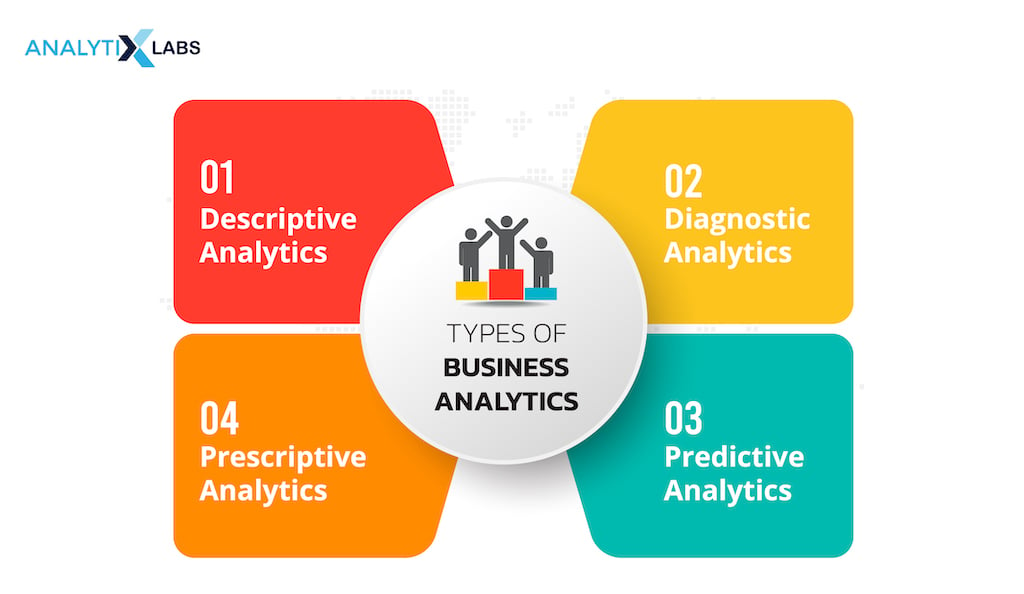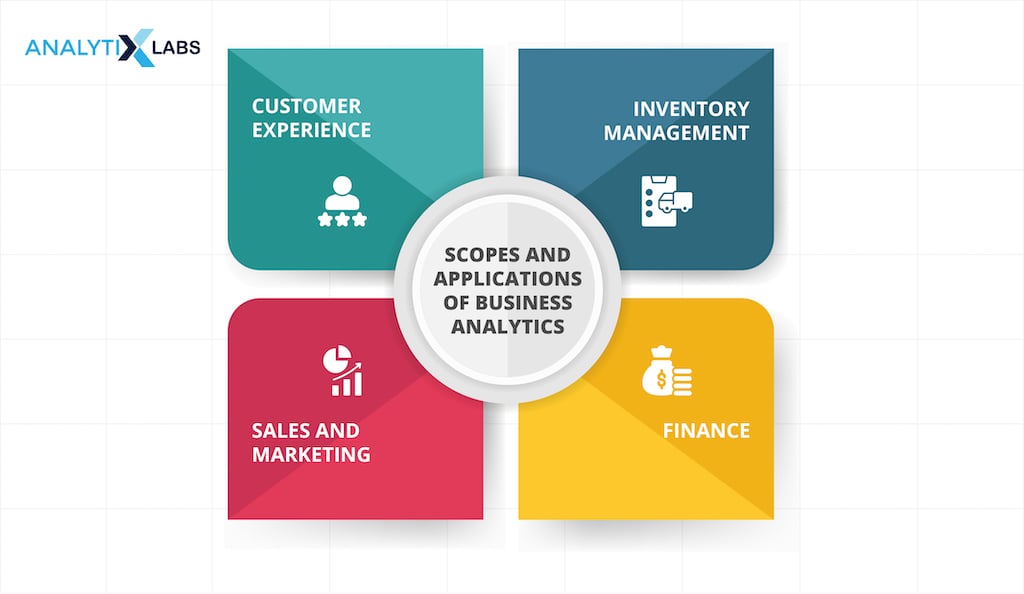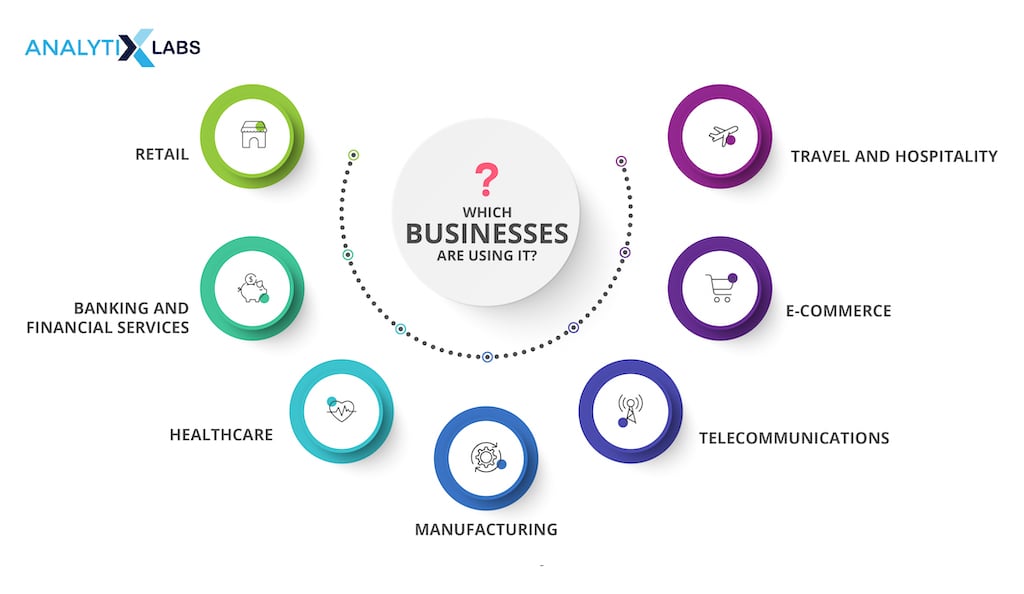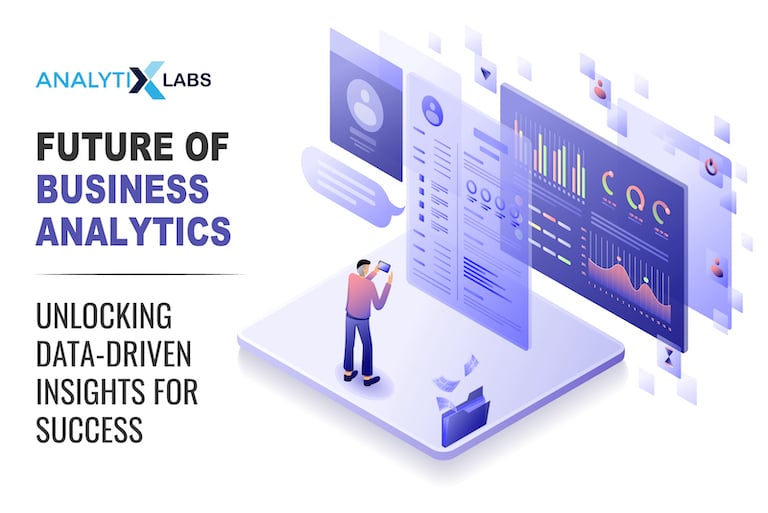Business analytics has recently garnered significant attention across various industries. With vast amounts of data circulating in every area of business—marketing, sales, finance, social media, and more—it is crucial to analyze and understand this data to enhance business decisions and drive market growth. This growing prominence sets the stage for exploring the future of business analytics.
To help you navigate this evolving landscape, AnalytixLabs offers a comprehensive Business Analytics course. Designed to equip you with the latest tools and techniques, our course prepares you to make data-driven decisions and excel in today’s competitive market.
Explore our Business Analytics 360 course and join us for experiential learning that will transform your career.
Check out our upcoming batches or book a free demo with us. Also, check out our exclusive enrollment offers
With this article, you will get a clear insight into the use cases, scope, and future business analytics for all the leading businesses.
What is Business Analytics?
Business analytics is analyzing business data utilizing data and statistical techniques to generate insights that may be used in corporate decision-making. Extensive data sets from numerous sources, including sales data, customer profiles, market trends, and financial records, are gathered, organized, and analyzed using various methods, tools, and technology.
Business analytics aims to uncover patterns, trends, and relationships within the data to provide valuable insights and support strategic decision-making. These insights can help businesses optimize their operations, improve efficiency, identify new opportunities, mitigate risks, and enhance overall performance.
Types of Business Analytics

Organizations use various business analytics techniques to obtain knowledge and make wise choices. These types can be grouped based on the nature of the analysis and the purposes they serve. Here are a few common types of business analytics:
Descriptive Analytics
It is the most basic form of analytics, focusing on summarizing findings and understanding what is going on in the data. It analyzes existing data using descriptive statistics, such as arithmetic operations, mean, median, max, and percentages.
This type of analytics is often called advanced analytics or business intelligence, accounting for around 80% of business analytics.
Common tools used in descriptive analytics include MS Excel, MATLAB, SPSS, STATA, and similar software packages. These tools facilitate the processing and analysis of data, making it easier to derive insights and present them comprehensibly.
Diagnostic Analytics
Diagnostic analytics is focused on determining the reasons or causes behind past events or outcomes. It involves techniques such as drill-down analysis, data discovery, data mining, and correlations to understand better the underlying factors contributing to specific results.
Diagnostic analytics delves into the data to identify the root causes, relationships, and sequences of events that led to a particular result. It utilizes probabilities, likelihoods, and the distribution of outcomes to analyze and uncover insights. This type of analytics is particularly useful in understanding why specific trends or changes occurred in the data.
For example, in time series sales data, diagnostic analytics could help uncover the factors contributing to a decrease or increase in sales during a specific year or period.
Predictive Analytics
Predictive analytics is indeed focused on predicting future outcomes based on existing data. It involves the development and validation of models that can provide accurate predictions. Predictive analytics builds on the descriptive analytics stage and utilizes the understanding of existing data to extrapolate and forecast future data.
One common application of predictive analytics is sentiment analysis, where opinions expressed on social media are collected and analyzed to predict the sentiment of individuals toward a particular subject in the future (positive, negative, or neutral).
Predictive analytics relies on machine learning algorithms such as random forests, support vector machines (SVM), and others, as well as statistical techniques for learning and testing the data. Building accurate predictive models often requires the expertise of data scientists and machine learning experts within companies.
Prescriptive Analytics
Prescriptive analytics goes beyond predictive analytics to suggest future solutions. It considers various courses of action and their favorable outcomes. It uses a feedback system to learn and update the relationship between actions and results. Computation involves optimizing functions related to desired products.
For example, ride-hailing apps use GPS to connect users with nearby drivers, optimizing distance for faster arrival. Recommendation engines also employ prescriptive analytics. Simulation combines vital performance areas to design solutions, ensuring relevant metrics are included.
Prescriptive analytics is considered the final frontier of advanced analytics or data science due to its ability to suggest favorable solutions.
Also read: What Are Different Types of Business Analytics?
Business Analytics & Business Intelligence
Companies generate a staggering quantity of data each day. It would help if you had techniques and tools to transform your data into valuable insights to make better decisions, spot issues, and make money.
Data management solutions are used to comprehend historical and current data and generate insights. These solutions include business intelligence (BI) and its subsets, business analytics, and data analytics.
- Business Analytics employs only previous data to operate operations supporting customer needs and boosting productivity. Whereas Business Intelligence incorporates past and present data.
- Business Analytics focuses on several tools that carry out various operational applications utilizing various tools, while Business Intelligence focuses mainly on reporting the analyzed data.
- Business intelligence establishes current patterns and identifies the causes of recent results or events using statistical analysis, predictive analysis, and predictive modeling. On the other hand, business analytics has no control over the vast amounts of data to be retrieved, examined, reported, and published.
- A User Interface Dashboard is part of business intelligence and is used for operations and analysis. As a result of the numerous tools available for use, business analytics requires some knowledge of software applications to complete the tasks at hand.
Scopes and Applications of Business Analytics
With the changing dynamics and technology today, every small, medium, and big enterprise depends on business analytics to channel their company resources in increasing revenue and cutting operational costs simultaneously.
Forecasting demand, spotting potential supply chain disruptions, risk assessment, and offering crisis support are examples of how business analytics may help.

Customer Experience
The key to smooth business operations is ensuring a quality customer experience. Business analytics empowers businesses to gain profound insights into their customer base, including their preferences, purchasing behaviors, and overall patterns.
By thoroughly studying and comprehending these aspects, companies can effectively customize their offerings to meet customer expectations, enhance satisfaction, and cultivate unwavering loyalty to their brand.
With the help of business analytics, organizations are granted the opportunity to personalize their products and services, ensuring that they align perfectly with their customer’s unique needs and desires.
This personalized approach fosters stronger connections with customers and drives long-term success by establishing a competitive edge in the market.
Inventory Management
The overhead costs and supply chain processes will be improved using inventory management. By analyzing the data, businesses can gain insights into the frequency and timing of orders, determine which products are in high demand, and assess their readiness to meet customer needs.
With this understanding, businesses can strategically plan their supply chain operations, ensuring efficient inventory management, timely deliveries, and minimized stockouts.
Moreover, business analytics empowers businesses to scale their services sustainably by identifying opportunities for expansion, evaluating resource allocation, and making data-driven decisions to support growth.
Through analytics, businesses can streamline their supply chain operations, reduce costs, and enhance competitiveness.
Sales and Marketing
Businesses can analyze customer responses to their marketing campaigns and product offerings to develop customized campaigns and identify optimal cross-selling and upselling opportunities.
This process entails examining various aspects, such as customers’ age demographics, average income, and purchase motivations, to predict patterns and trends in their buying behavior.
By understanding these factors, companies can tailor their product messages and launch timings to align with their customer’s needs and preferences, ultimately enhancing customer satisfaction and driving sales.
Additionally, studying customer reactions enables businesses to refine their marketing strategies, optimize resource allocation, and allocate budgets more effectively.
Finance
Big data and business analytics enable companies to manage their finances more efficiently. By gaining insights into their marketing spend and comprehensively understanding incoming and outgoing transactions, businesses can significantly improve their decision-making processes and allocate resources more effectively.
A study conducted by McKinsey & Company demonstrated that adopting an integrated analytics approach to analyze marketing expenditure can unlock up to $200 billion in savings on a global scale.
This emphasizes the significant impact that leveraging data and analytics can have on optimizing financial operations and maximizing business value.
Which Businesses are using it?

Companies have to opt for business analytics today to grow their businesses and stand out in the ever-increasing market competition. Many industries are working with BA; here we have discussed a few of them:
Retail
Retailers use business analytics to analyze customer behavior, optimize inventory management, forecast demand, and personalize marketing campaigns. Companies like Walmart, Amazon, and Target heavily rely on business analytics to improve their operations and enhance the customer experience.
Banking and Financial Services
Banks and financial institutions leverage business analytics to assess credit risk, detect fraud, optimize investment portfolios, and personalize customer offerings. Institutions like JPMorgan Chase, Goldman Sachs, and Citigroup employ advanced analytics techniques to make data-driven decisions.
Healthcare
Healthcare organizations utilize business analytics to improve patient outcomes, optimize resource allocation, identify cost-saving opportunities, and enhance operational efficiency. Companies like Johnson & Johnson, Pfizer, and UnitedHealth Group use analytics to analyze patient data, optimize clinical trials, and improve healthcare delivery.
Manufacturing
Manufacturers employ business analytics to optimize production processes, reduce costs, forecast demand, and improve supply chain management. Companies like Toyota, General Electric, and Procter & Gamble utilize analytics to streamline operations, improve quality control, and enhance productivity.
Telecommunications
Telecommunication companies use business analytics to analyze customer usage patterns, predict customer churn, optimize network performance, and personalize marketing offers. AT&T, Verizon, and Vodafone use analytics to improve network reliability, enhance customer satisfaction, and drive revenue growth.
E-commerce
Online retailers and e-commerce platforms heavily rely on business analytics to understand customer preferences, optimize pricing strategies, personalize recommendations, and improve conversion rates. Companies like Amazon, Alibaba, and eBay use analytics to analyze large volumes of customer data and drive their business strategies.
Travel and Hospitality
Travel companies and hotel chains utilize business analytics to optimize pricing and revenue management, enhance customer experience, and personalize marketing efforts. Companies like Marriott International, Expedia, and Airbnb employ analytics to analyze customer reviews, optimize hotel bookings, and tailor travel recommendations.
Future of Business Analytics in India
The reach of business analytics is expanding and becoming more mainstream as firms of all sizes and analytics skill levels enter the big data game. Exploring business analytics necessitates the correct focus, technology, people, and a clean culture. Companies like IBM, Cognizant, and KPMG use business analytics technologies to make valuable and effective judgments.
Business-as-a-Service (BaaS) Will Be In Demand
Strong business models are being built by integrating industry-specific applications, tools, and services into the cloud. Rather than acquiring generic function libraries and individual APIs, businesses prefer to purchase pre-built processes tailored to their specific industries.
Major cloud service providers like Google Cloud Platform, Amazon Web Services (AWS), and Microsoft Azure are at the forefront of this trend. They offer specialized solutions for various industries, such as banking, retail, manufacturing, hospitality, security services, predictive maintenance, and more.
For instance, the Ford Motor Company has partnered with AWS to access advanced connectivity, storage, and computing capabilities for its car application development platform. This platform enables the development of cloud-connected vehicle services, incorporating the Internet of Things (IoT), machine learning (ML), analytics, and computing.
Enterprises across different sectors will increasingly seek cloud-centric solutions. Allied Market Research shows the cloud services market is projected to reach $1,620 billion by 2030.
Vertical-specific solutions are gaining popularity, and more businesses are considering adopting them. Customized cloud solutions allow for the delegation of tasks to automation modules and add-ons. This flexibility empowers businesses to focus on strategy and processes, enabling them to differentiate themselves in the market.
Data Fabric Adoption Will Rise
A data fabric is a setup for integrating and managing information from various sources using metadata indexing. According to IBM, enterprises looking for software solutions consider data fabric a fundamental requirement. Integrating data from multiple systems to gain quick insights is a crucial business need.
By utilizing virtualization, a data fabric allows organizations to maximize their digital assets by accessing information when needed. It serves as a key driver for data marketplaces, eliminating the need to move data across systems, which is particularly advantageous in today’s fast-paced environment with frequent deployments.
A data fabric is a foundation for data marketplaces, enhancing efficiencies and maintaining enterprise competitiveness. AI capabilities at the backend enable end-to-end information management, reducing reliance on specific environments and processes. Automated integration, governance, and usage auditing relieve teams from mundane tasks.
Aligning business needs with governance protocols is of utmost importance, and a data fabric helps break down existing silos to achieve this goal. By optimizing usage and leveraging automation, teams can focus more on strategy, innovation, and processes.
Information Governance Will Remain a Priority
The value of information increases when it is shared, as mentioned earlier. The current State of Cloud Data Governance survey states that the main drivers for organizations are quality and analytics rather than just risk management.
By implementing effective governance, organizations can improve their models for analysis. How does this happen? Governance solutions maintain mappings of information stored in various systems, and the data fabric serves as a unifying element, eliminating the need to develop code.
Machine learning plays a role in enforcing regulatory compliance while learning from and replicating previous data search outcomes.
Information governance has evolved to focus on metadata-driven quality and decentralized control over shared insights. While data stewards remain important, they can avoid excessive control through automated access approvals that align with compliance requirements.
Data stewardship now involves a proactive role in ensuring that governance protocols keep up with operational needs, many of which rely on real-time insights. Access rules that lag behind the real-time requirements of the business become ineffective.
Establishing decentralized access by delegating control is a primary challenge for enterprises. Additionally, ensuring complete transparency of audit trails when regulatory bodies request is another important consideration.
Data Privacy and Security Will Be Paramount
In recent years, business analytics and business intelligence have faced numerous challenges, including regulations and scandals, that have raised concerns about its future. Data breaches have particularly sparked discussions on information security and ethics despite implementing cloud firewalls and zero-trust protocols.
Surprisingly, the number of data breaches has continued to rise, causing significant financial damage to organizations. According to an IBM report (accessible by gated access), a single breach can cost a company as much as $4.35 million.
As cloud platforms expand their offerings, companies are increasingly looking to integrate cyber risk management into the software deployment process at an earlier stage. More than relying on service-provided security measures may be required to address specific requirements. This has led to a growing demand for customized cybersecurity modules tailored to the organization’s needs.
Another significant aspect of risk management today is AI data governance, which presents new challenges for enterprises as they navigate the complexities of managing and securing AI-driven processes and systems.
Automation Will Continue to Make Life Easier
Automation is primarily motivated by decreasing labor costs and optimizing resource utilization. AC (Automation code) can handle a wide range of easy and complex tasks and the entire infrastructure of business systems.
Administrative tasks such as monitoring, reviewing, and approving tasks, managing databases, integrating systems, and applying operating system patches are ideal candidates for task-level automation. However, when it comes to infrastructure-level automation, the approach differs significantly.
Cloud-based platform-as-a-service (PaaS) solutions provide user-friendly programming interfaces that allow users to customize applications without requiring coding knowledge, with automation running in the background.
Infrastructure-as-code is another architectural approach that relies on code-driven management of backend elements such as source connections, networks, and computing and storage resources.
These pre-packaged solutions enable businesses to achieve consistency, scalability, and efficiency quickly. This will help surpass the challenges of managing individual components within an integrated software suite. Automation ensures consistent and audited actions, reducing errors and instilling trust in the reliability of outcomes.
An example of such a solution is the Oracle Autonomous Database. This platform operates autonomously, adjusting and optimizing itself while performing self-patching and automatic disaster recovery on Exadata infrastructure. This significantly alleviates the burden of deploying databases by shifting certain data center operations to the cloud.
Conclusion
“Business analytics is the bridge that connects the gap between information and informed decision-making.” – Thomas Davenport
Business analytics has emerged as a powerful tool for organizations to gain valuable insights from vast data. By leveraging advanced analytical techniques and technologies, businesses can make data-driven decisions, optimize operations, identify trends, and unlock new opportunities for innovation and growth.
FAQs
- Is there any future in business analytics?
Prescriptive analytics is set to play a pivotal role in shaping the future of business analytics, providing valuable insights to guide business strategies. Decision-makers and managers will be at the forefront of driving this transformation, leveraging self-service BI and analytics capabilities to empower technical and non-technical users and promote a more level playing field.
- Is business analytics a good career in the future?
Due to the growing need for qualified experts in the field, business analytics is expected to be a rewarding career in the future. Every year, conferences are held by organizations like Microsoft and Google to entice more people to join the Big Data movement.
With an average yearly salary of 7.0 lakhs, business analytics is regarded as one of the more lucrative professions.
- Is business analytics an IT job?
The position of a business analyst is not an IT job unless they specialize in the IT sector, in which case their title would be an IT business analyst. Other industries, however, require business analysts to be familiar with information technology and important business applications that improve workflow.








